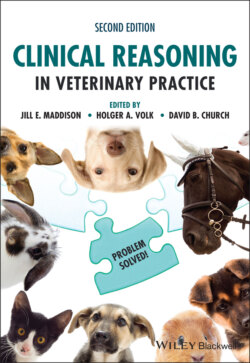Читать книгу Clinical Reasoning in Veterinary Practice - Группа авторов - Страница 16
Introduction to clinical reasoning
ОглавлениеWe all remember our first driving lessons, which may have been quite challenging – for us and/or our instructors! We had to think actively about many factors to ensure we drove safely. The more experienced we became at driving, the more non‐driving‐associated tasks, such as talking to our passengers, listening to the radio and changing the radio channels, we were able to do while driving. If we had attempted any of these tasks at the beginning of our driver training, we might have had an accident. As we become more experienced at a task, we need to think less about it, as we move to what is known as unconscious competence (Figure 2.1).
Figure 2.1 Skill acquisition pathway. (This pathway can apply to the acquisition of any skill.)
We see a similar process in clinical education. During the progression from veterinary student to experienced clinician, knowledge and skills are initially learnt in a conscious and structured way. Veterinary undergraduate education in most universities is therefore based on systems teaching, discipline teaching, species teaching or a mixture of all three. These are excellent approaches to help develop a sound knowledge base and understanding of disease processes and treatments.
However, when an animal or group of animals becomes unwell, the clinical signs they exhibit can be caused by a number of disorders of a range of different body systems – the list may seem endless. They do not present to the veterinarian with labels on their heads stating the disease they have (more’s the pity!). Therefore, for veterinarians to fully access their knowledge bank about disorders and their treatment, they need to have a robust method of clinical reasoning they can rely on. This method allows them to consolidate and relate their knowledge to the clinical case and progress to a rational assessment of the likely differential diagnoses. This makes it easier to determine appropriate diagnostic and/or management options for the patient. Because you have a clear path, communication with the client becomes easier.
The next part of the journey to becoming an experienced clinician is that clinical judgement and decision‐making processes become unconscious or intuitive. The rapid, unconscious process of clinical decision‐making by experienced clinicians is referred to in medical literature as intuition or the ‘art’ of medicine. The conscious thinking process is often referred to as ‘science’ (evidence based) or analytic. Intuition is context‐sensitive, influenced by the level of the clinician’s experience, context‐dependent and has no obvious cause‐and‐effect logic. Why is this important? We have all thought ‘I just know that the animal has …’ The unconscious mind will pretend to the conscious mind that the clinical decision was based on logical assumptions or causal relationships. This is not a problem as long the intuition or ‘pattern recognition’ has resulted in a correct diagnosis. However, when it does not, we need to understand why it failed and have a system in place to rationally progress our clinical decision‐making.
This book will provide you with the tools and thinking framework needed to unravel any clinical riddle, unleashing the potential of your unconscious mind rather than blocking your working memory as you try to recall all of the facts you may have once known.
